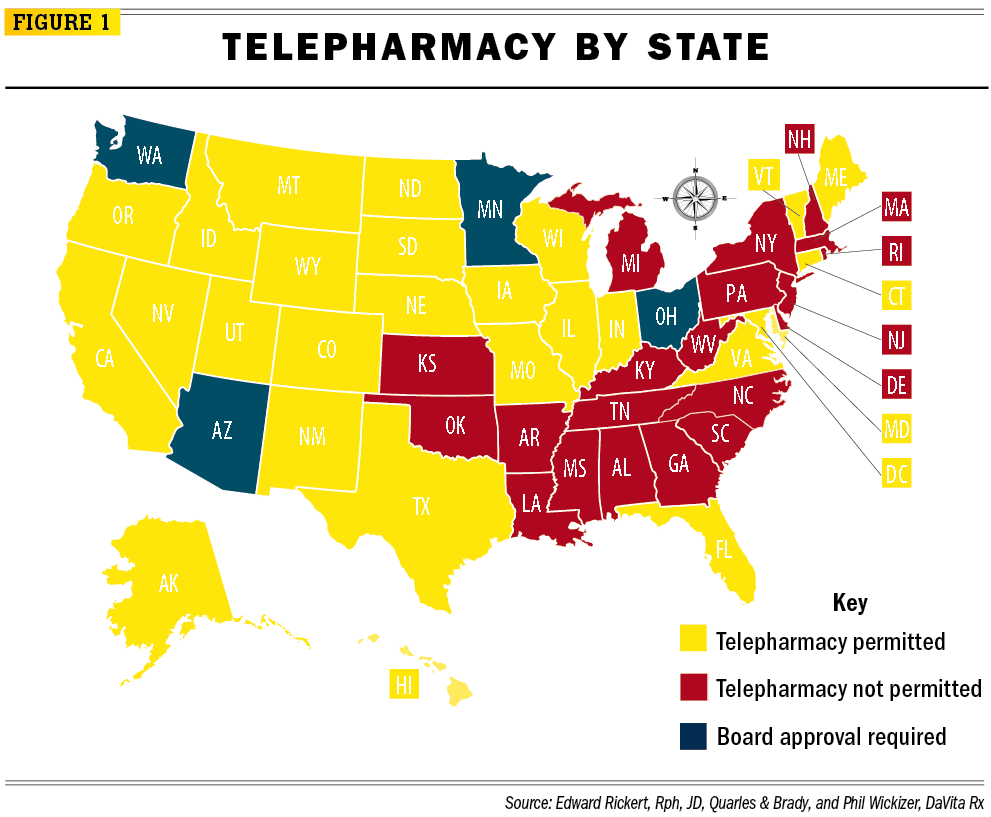Connected: Telepharmacy unites the team
Now, that pharmacist on the other side of the country is only a mouse-click away.
It's 3:00 a.m. A 7-year-old with an elevated fever is brought to the emergency room of a Midwestern hospital by his parents. The emergency room physician performs an evaluation and writes several medication orders. But this particular hospital does not have 24/7 pharmacy coverage. Not to worry. A certified pharmacist working at a remote location reviews the orders and the patient's electronic medication record online, and verifies that everything is accurate from a pharmacy perspective. A question about the dosing occurs to the ER doctor and he consults with the pharmacist via a video/audio link.
That scenario, an illustration of how telehealth and telepharmacy are altering the healthcare landscape, plays out thousands of times every day.
See also: Telepharmacy pulls hospital through storm
And itâs not just in the hospital setting that telehealth and telepharmacy are making an impact. Telehealth and telepharmacy originated in rural areas where there isn't a community pharmacy for miles. Patients in those regions are able to get their prescriptions verified by a pharmacist only through the use of technology (Table 1).
At its core, telehealth delivers healthcare services and information by means of a variety of telecommunications technologies. Telepharmacy, according to the National Association of Boards of Pharmacy (NABP), is defined as the provision of pharmacist care from a distance to patients through the use of telecommunications and other technologies.
Data from the National Conference of State Legislators indicate that the use of telehealth services is expected to increase from 250,000 patients in 2013 to 3.2 million by 2018. In addition, figures from the Center for Connected Health Policy reveal that more than 200 telehealth-related bills were introduced in 42 states in 2015.

Convenience and access

Edward RickertThose statistics come as no surprise to Edward Rickert, RPh, JD, a partner at Quarles & Brady, a national law firm with offices across the country that specializes in pharmacy law.
One of the primary drivers of telehealth and telepharmacy is the fact that people like convenience and they are used to getting things quickly and easily, said Rickert, citing the example of automated banking.
"Society as a whole is transitioning over to this idea," said Rickert. "People want accessibility on their iPhones or PCs. And coupled with that, specific to telehealth and telepharmacy, issues of access and convenience are making it easier for patients to obtain healthcare, which will also help to increase compliance and improve outcomes."

Mark HardyMark Hardy, PharmD, executive director of the North Dakota Board of Pharmacy, told Drug Topics that the use of telepharmacy is gaining ground and that states are working to develop rules and standards for it.
Hardy pointed out that telepharmacy also has had an impact on employment opportunities for pharmacists.
"It has opened up more practice settings that pharmacists can use," he said. "Access to healthcare is an issue for us in the Midwest and in rural areas, and using services like this is important to ensure that patients have access to care across these states."

Allie WoodsAllie Woods, PharmD, director of ASHP's Section of Pharmacy Informatics and Technology, said that while telepharmacy originated in rural areas where there was not enough workforce necessary to meet community demands, it is also being used to support medication use in more and more health systems.
Some health systems have satellite pharmacies that are not open 24 hours per day and telepharmacy is being used for order review and verification, said Woods.
The bottom line, Woods said, is that âtelepharmacy can be used wherever there is not a pharmacist physically present to help provide the quality of care thatâs needed.â
Woods added that ASHP's policy statement on telepharmacy is currently under review and will be finalized soon.
Software fuels demand
Iowa City-based TelePharm is a software company that has created a platform for remote delivery of healthcare, prescription verification, and workload-balancing services across the United States. This software enables underserved areas to have pharmacy access.
See also: Telepharmacy offers hospitals dramatic cost savings

Adam CheslerAdam Chesler, PharmD, vice president of pharmacy services at TelePharm, said that demand for telepharmacy has grown.
"As technology has advanced, telepharmacy has become a reality. Demand for rural access to healthcare has skyrocketed," he said.
NuCara, a community pharmacy chain based in Conrad, Iowa, uses TelePharm's software. Brett Barker, PharmD, vice president of operations, said that the telepharmacy component of the business has been a "great success."
"We have two questions that we ask ourselves,â he said. âFirst, 'Are we improving patient care?' and second, 'Are we extending the reach of the pharmacist?' Those are the two things that we want to accomplish. It's been steadily growing in volume since the day we opened," said Barker.
University of Wisconsin Health Systems, also a TelePharm customer, provides prescription dispensing and pharmacist patient-care services in a clinic setting.

Steven RoughSteven Rough, MS, RPh, director of pharmacy, explained that some clinics are too small to be able to justify the cost of a full-service pharmacy at their location.
"However, we still want those patients to have access to patient-care services provided by a pharmacist, and we still want to ensure that they have an efficient means to fill their prescriptions," he said.
According to Rough, this is where remote dispensing via telepharmacy technology comes in handy.
"We are able to establish remote dispensing sites with an onsite pharmacy technician in these clinic locations. The technician can dial in the pharmacist from an offsite location via remote video technology to confirm that the right drug is being dispensed and to teach patients about their new medications and emphasize the importance of adhering to their regimens. This provides a very cost-effective means for optimizing patient care,â said Rough.
The ambulatory pharmacy services at University of Wisconsin Health Systems handle 2,000 prescriptions per day across 14 pharmacies located in different medical office buildings or hospitals, according to Joe Cesarz, MS, PharmD, manager of ambulatory pharmacy services.
"Our core business is dispensing pharmacy services, which includes our specialty pharmacy program, primary care ambulatory care pharmacist services, and population health pharmacy services â so anything that is outside of the inpatient setting,â Cesarz said. "We provide ambulatory pharmacy services in these 14 pharmacies that we operate. We have clinical pharmacists who are part of the interdisciplinary care team in primary care clinics and in specialty clinics," he said.
Serving eight states
Virtual Health Services (VHS), a subsidiary of Catholic Health Initiatives (CHI) based in Englewood, Colo., is a not-for-profit entity formed in July 2012 to take advantage of new technologies to bring clinical services to its market, said Win Vaughan, president, CHI Virtual Health Services.
The VHS telepharmacy program provides rural hospitals with 24-hour access to the services of experienced clinical pharmacists, including virtual medication order review and verification, and clinical intervention services, all in real time.
To date, Vaughan said, the program has been very successful.
"When we started, we had about 12 hospitals in the program, and we now support over 50 hospitals in eight states. The states where we provide telepharmacy services are in markets where our parent company, CHI, has a significant presence from a hospital and health-system perspective," he said. The No. 1 focus is to support their hospitals and work together with them to allow pharmacists the time to participate in clinical programs.
Increasingly, telepharmacy is becoming a solution for hospitals that don't have pharmacy coverage 24/7.

Scott BurnsAt Rome Memorial Hospital, a 130-bed community hospital in Rome, N.Y., Director of Pharmacy Scott Burns, RPh, considered expanding the pharmacy to 24 hours, but it just wasn't cost-effective. Instead, he turned to a telepharmacy solution from San Francisco-based PipelineRx to cover the pharmacy during off hours.
PipelineRx pharmacists worked in conjunction with hospital IT personnel to gain access to a patients' electronic health record (EHR) remotely and review medication orders.
"PipelineRx is an extension of the in-patient pharmacy department. They follow the same policies and procedures as they would if they were in-house," Burns said.

Obstacles to growth
Despite the growth and interest in telehealth and telepharmacy programs, there remain barriers to growth.
At the 2016 annual meeting of the American Pharmacists Association, Rickert and Phil Wickizer, assistant general counsel for DaVita Rx, a full-service pharmacy based in Coppell, Texas, led a session titled "Hot Topics in Telehealth and Pharmacy." Among the barriers to growth in these areas, they cited:
- Payment issues. Payment can be problematic in dealings with both governmental and private payers.
- Licensure. For healthcare professionals, especially when it comes to practicing across state lines, licensure can impede the ability to offer telehealth services.
- Online prescribing. Physicians must be able to prescribe medications to patients treated through telehealth, but currently in most states patients must be physically examined before a medication can be prescribed.
- Security concerns. How telehealth services relate to existing legal and regulatory rules pertaining to privacy and security must be determined.
Regulators
Rickert and Wickizer also touched on how regulators are reacting to telemedicine and telepharmacy, noting that in 2013, the FDA "issued guidance on how they intend to regulate the emerging world of medical applications that have the ability to impact patient health and safety."
In addition, they brought up the U.S. Drug Enforcement Administrationâs EPCS â Electronic Prescriptions for Controlled Substances â and the Ryan Haight Online Pharmacy Consumer Protection Act, which "provides that no controlled substance may be 'delivered, distributed, or dispensed by means of the internet without a valid prescription.' â
The Centers for Medicare & Medicaid Services (CMS) have also issued guidelines on telehealth services. These can be found at the CMS website (http://bit.ly/telehealthsrvcs)
When it comes to the regulators, telepharmacy faces a lot of hurdles, said Rickert.
"The technology has outpaced regulations, and very few states fully adopt all aspects of telepharmacy," said Rickert, who pointed out that what's permitted varies from state to state. In addition, there is no common definition of what telepharmacy is and what types of telepharmacy are permitted.

Many states recognize telepharmacy, Rickert noted, but what they envision is a brick-and-mortar pharmacy that is staffed by a technician with an audio/video link to a pharmacist 50 miles away (Figure 1). Rickert noted that this figure may be misleading, in light of how ambiguously individual states define telepharmacy, but it gives a general overview of the current regulatory framework.
"But they don't recognize the remote dispensing technology and some of the things that are really the next wave of telepharmacy. You have to go state to state to get that technology approved," said Rickert. He added that it is a burdensome process to convince regulators either to grant waivers or to write new rules to permit this type of technology.
What the future holds
Many healthcare practitioners, pharmacists, technology, and legal experts believe that when it comes to telehealth and telepharmacy, the future is bright in terms of its impact on both patient care and efficiency.
"As the public becomes more aware of the types of telehealth and telepharmacy services available, and as regulators begin recognizing the usefulness of some of this technology, I think you are going to see more and more states get on board. Anything that can improve access to healthcare and pharmacy services can improve patient care, and should be embraced by regulators who are charged with protecting the public," Rickert said.